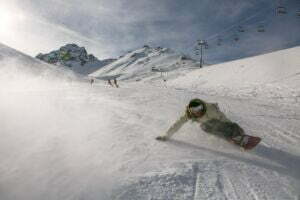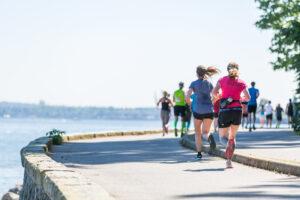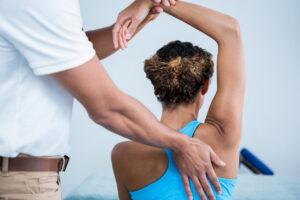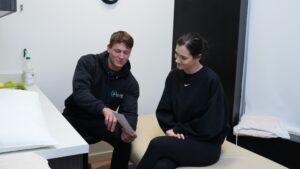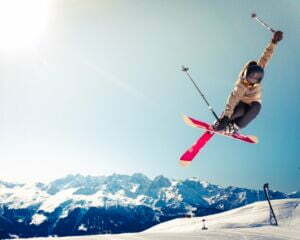
One of the greatest advantages of living in Vancouver in the wintertime is ski season. Escaping to a nearby snow-coated mountain, hitting the slopes, and winding down with a hot chocolate at the lodge is a weekend ritual for many people and visitors of the lower mainland.
Skiing and snowboarding are ideal forms of exercise when it’s too cold out to go for a run and play outdoor sports. Unfortunately, we see patients coming in every year who must cut their season short due to unforeseen injury on the mountain.
Any avid skier or snowboarder will tell you that they have seen many people get transported down the hill on a snowmobile by medics — it’s not a great way to end a day on the mountain! That’s why our team at Synergy Rehab wanted to give you a list of 10 quick tips to prevent skiing and snowboarding injuries this season.
First things first, let’s start with the most common ski and snowboard injuries we see coming into our clinics. Although skiing and snowboarding are such different movements and sports, many of the injuries are the same.
Most common skiing and snowboarding injuries
- Wrist fractures
- ACL ruptures or sprains
- MCL ruptures or sprains
- Shoulder sprain, fracture, or dislocation
- Thumb fractures
- Head injuries
- Whiplash
- Concussions
- Spinal injuries
- Knee injuries
- Spinal injuries
- Hand injuries
Top ten tips to prevent skiing and snowboarding injuries
1. Regular cardio exercise
Healthy nutrition and overall cardiopulmonary (heart and lung) health is vital for injury prevention. Fatigue and muscle strain are primary contributing factors to ski and snowboard injury. The most common types of injuries occur from the combination of muscle fatigue and ‘getting that last run in’ at the end of the day. These injuries can be minimized by implementing regular exercise into your routine leading up to and during ski season.
2. Warm up
Put simply, cold muscles are at a greater risk for injury. By gently stretching your hamstrings, quadriceps, hips, and calf muscles before and after skiing or snowboarding you help protect your body from any potential strain or fracture.
Warming up:
- Increases your body and muscle temperature. This will increase blood flow to your muscles which also increases the rate of energy production.
- Creates higher muscle temperatures which results in improved contraction and reflex times.
- Decreases the likelihood of soft tissue injuries (tendons, muscles, and ligaments).
3. Wear a helmet
You’ve heard this one before and for good reason. If you fall, a properly fitted helmet can dramatically reduce the risk of ski and snowboard head injuries. Helmets can also provide protection in the event of a collision with another boarder or skier.
4. Stay hydrated
Did you know you lose twice as much water when at higher altitudes compared to sea level? This means it is twice as important to stay hydrated when doing winter sports. When it comes to things to consider when going for a ski or snowboarding trip, most people overlook preparing their bodies yet go great lengths to prepare for the adventure in terms of attire and gear.
It may seem counterintuitive, staying hydrated during winter. However, staying hydrated is of utmost importance for your health, performance, and safety. Water is the largest component of blood, and it is needed to transfer both oxygen and nutrients. When you are dehydrated, blood flow and consequently oxygen and nutrient flow to the muscles is cut off. Weak muscles will, in turn, affect your performance.
5. Choose the right equipment
When renting or buying ski or snowboard equipment, don’t overstate your skill level. Make sure you get equipment that will be safe for you and your ability. This could mean the difference between your ski season being cut short or enjoying the whole ride!
6. Protect your eyes and wear sunscreen
While UV rays from the sun may not be as strong during the winter, sunscreen should be a necessary addition to your ski and snowboard kit. The reflection off the snow amplifies the effects of UV rays making you more vulnerable to burning. You’re also at higher elevation, making the sun’s effects stronger. Sunglasses and/or goggles should also always be worn on the slopes to protect your eyes and see other skiers and boarders clearly.
7. Ski specific tip: do squats
Squats are a great exercise to build quad and glute strength and prevent knee injury. This is a motion you are going to be doing a lot of skiing. Many people do squats incorrectly, and then complain of knee or back pain. Make sure to check in with your physiotherapist to ensure proper alignment and form.
8. Ski specific tip: use ski poles without straps
The main reason not to wear pole straps is that if you’re caught in an avalanche, the snow will pull on your poles and pull your arms away from your body. They can also drag you deeper into the debris, like a boat anchor. You want to be able to let go of your poles and have your skis come off your feet if you are ever caught in an avalanche.
In a less dramatic situation, poles without straps allow you to release the pole during a mishap which prevents snags that cause injuries to your thumbs and arms.
9. Snowboarding Specific Tip: Wear wrist guards
A snowboard constrains both legs and feet in strapped bindings. When a snowboarder begins to lose their balance, they will commonly extend their arms to brace the fall. When the wrist is flexed upwards during a fall, it absorbs the energy of the fall and causes a fracture or sprain.
An effective wrist protector absorbs as much of that energy as possible and protects boarders from hand, thumb, and wrist injury.
10. Listen to your body
Always listen to your body and rest when you’re tired. Most injuries on the slopes happen later in the day when fatigue sets in.
Schedule an appointment with Synergy Rehab
Skiing and snowboarding can be a blast and is a great way to keep active during the winter, but it can cause of many of the injuries we see at this time of year. We see everything from wrist fractures or concussions to thigh strains or back injuries to enhanced chronic pain from over doing it and not protecting yourself. One of the reasons winter sports can cause injuries is that they usually are not something we train for all year.
If you are looking for a physiotherapy clinic to help prevent or manage your winter sport injuries Synergy Rehab Surrey Nordel Physiotherapy is here. Our team of experienced therapists will help you find the best treatment options that suit your individual needs and get you back to feeling your best on the slopes. Contact us now to learn more about our treatment options.



